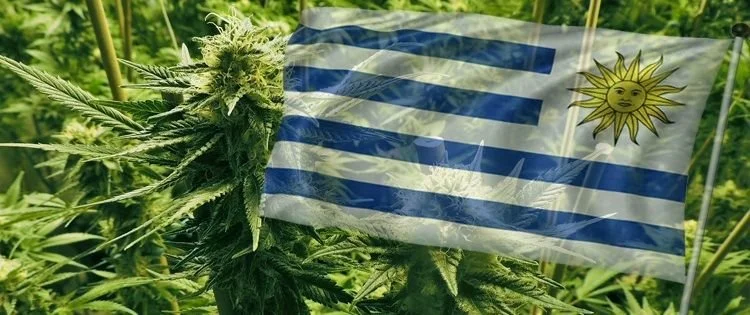Last Week In Weed Issue 40
Published September 20th 2021
In this week’s issue of Last Week In Weed, We’ll be looking at Uruguay wanting to open its cannabis market to tourists, WADA looking at removing cannabis from its banned drugs list, and Italy moving closer to a public referendum on the legality of cannabis.
Uruguay wants to welcome cannabis tourists
First up this week, we’ll take a look at Uruguay, the South American nation that was the first country to ‘legalise’ cannabis back in 2013. Nearly a decade later and the socially liberal nation looks set to finally allow tourists and non-nationals to purchase and consume cannabis from its pharmacies and smoking clubs.
Uruguay has an extensive history of cannabis cultivation and the tolerance of its consumption. Personal use of all drugs in the country has never really been criminalised, as back in 1974, legislation was passed that enabled judges to determine whether individual possessed drugs for personal or commercial purposes and deal with them accordingly.
Under current legislation in Uruguay citizens or residents can buy up to 40 grams a month from government-controlled and registered pharmacies. They may also ‘legally’ join a registered ‘cannabis smoking club’ that are licensed for between 15 and 45 members and are allowed to grow up to 99 plants annually for its members to purchase. Individual members are limited to only buying 480g (17oz) over the entire year, or the equivalent to just 9.23 grams a week.
The other option for Uruguayans to access cannabis is for them to register to a central government database to be allowed to cultivate up to 6 plants at home. The documenting of cultivation and consumption is done to ‘flag excessive consumption’ to help arrange ‘treatment’ and ensure that ‘they’re not selling their stash’, which remains illegal under current legislation.
Cultivation is capped at a maximum of 6 crops annually, with the total dried weight of the flowers not to exceed 480g (17oz) over the whole year. This works out at roughly 13.3 grams a plant over your maximum of 36 plants. A truly ridiculous low figure when you consider that it’s possible to get that return and more from a single plant these days.
The publicised primary motivator for changing the law in late 2013 was not the potential profits the government could make from taxing and selling cannabis, but the very concept of governmental control and centralise regulation. The legislation was produced to ensure that the government retained control of the market through the creation of strict rules and regulations.
This seems to be the same line being used here by both the tourism office and the national drugs board. Deputy Tourism Minister Remo Monzeglio recently said that “The aim isn’t to promote Uruguay as a destination for cannabis tourism, but rather to steer tourists away from the black market and into the regulated market”
The Deputy Tourism Minister has also floated the idea of charging foreign tourists higher prices to help ‘fund addiction treatment and rehabilitation programs.’ It is unclear at this point whether tourists would have to register with the centralised governmental database to join smoking clubs or purchase cannabis from its registered pharmacies.
“It seems to me that if we come up with a good proposal, Uruguay could open its regulated pot market to tourists for the upcoming tourism season, it’s highly unlikely, but I wouldn’t rule it out” – Daniel Radio, Secretary general of the Uruguay National Drugs Board
There does seem to be a touch of post-Covid economic blues affecting decision-making here too. In 2020 exports of cannabis flowers more than doubled to almost $7.5m. A far cry from the hundreds of millions predicted by ‘industry experts’ and venture capitalists eager to exploit, sorry help develop the nation as a player on the global cannabis market.
Although the market cap of $1 a gram has actually decreased and access is slowly increasing, I cannot help but feel that this is just another small step when they could be making giant leaps. Uruguay has a great climate for growing cannabis, a socially conscious citizenry, and despite its relatively high labour and energy costs, it could become a world leader in cannabis law reform and the wider global cannabis industry.
Allowing and encouraging cannabis tourism to the South American nation would certainly boost the government’s coffers, it could also hopefully help evolve its government’s position on cannabis beyond harm reduction to ubiquitous acceptance of cannabis consumption and its ever-growing culture.
WADA looks to remove cannabis from the banned drugs list
The World Anti-Doping Agency (WADA) announced last week that it will consider updating its rules around the consumption of cannabis in competitive sport. The move comes following the absence of amongst others US sprinter Sha’Carri Richardson from this year’s Tokyo Olympics.
One of the world’s fastest women, Sha’Carri Richardson was forced to miss the opportunity that some pundits said could have been her chance to cement her name as the fast woman on earth after failing a routine drug test. The US NCAA 100m record holder tested positive for THC, which is still considered to be a banned substance under current WADA rules.
As I mentioned in Issue 30 of Last Week In Weed, This is a rather interesting situation when you look at the contradiction in messaging here. The United States Anti-Doping Agency (ASADA) along with the World Anti-Doping Agency (WADA) classifies cannabis as a ‘performance-enhancing drug’ yet the US government and international bodies also classify cannabis as a ‘drug of abuse’. How can it be both?
WADA will prohibit a drug if it meets two of the following criteria;
– The substance is considered a performance enhancer
– The substance potentially pose a health risk to athletes
– Its use violates the ‘spirit of sport’
We know cannabis isn’t a health risk so the other two criteria used to ban THC are that it is a performance enhancer and that its consumption violates the ‘spirit of sport’ set out by WADA. ‘Spirit of Sport’ is defined by WADA as “the celebration of the human spirit, body, and mind,” adding that ‘it reflects the values of sports, such as character, teamwork, and fun and joy.’ How they can say that cannabis isn’t an aid to “the celebration of the human spirit, body and mind” is beyond me.
Last Tuesday (Sep 14th) WADA met to discuss amongst other things its stance on currently prohibited substances. This resulted in the international organisation committing to conducting a scientific review of cannabis’ place on the banned substances list. However, the sporting regulatory organisation has said that it will remain banned through 2022.
Finally, a little progression in this space. For far too long the pushing of zero-THC products to ‘protect’ the image of sports stars and personalities has diluted the wider and more important cannabis debate. The global inclusion and acceptance of THC and cannabis into sport will only help advance the basic human rights of all cannabis consumers if done correctly.
Cannabis referendum hopes for Italian cannabis consumers
Finally, this week, we’ll be looking once again at Italy. As discussed in issue 41 of Last Week in Weed, Italy announced that it intends to ‘decriminalise’ the personal cultivation of cannabis at home, while increasing penalties for other related offenses such as trafficking and trade.
Just a week later and it looks likely that the Mediterranean nation will now be forced into holding a citizens-led referendum on further ‘decriminalisation’ measures and cannabis legal reforms. Spurred on by the previous week’s news regarding the potential ‘decriminalisation’ of home cultivation, a group of Italian cannabis advocates launched a petition calling for the expansion of that initial decision to include small-scale sales.
Organisers were able to gather the requisite half a million signatures in just seven days thanks to a recent law change in July that allows for the collection of signatures online. Another petition started at a similar time seeking to ’legalise’ euthanasia has already passed 900,000 signatures.
“This success is explained by factors, from a technical point of view, setting the referendum up and signing it has become much easier thanks to the introduction of digital signatures, which seriously cut organisation costs.”
“From a political point of view, the cannabis issue is now mature. There are around a million cannabis consumers in Italy. The people who use it are not the kind of marginalised members of society as right-wing parties describe them, and many parts of the United States have made it legal through referenda too” – Giuseppe Civati, Founder of Possibile (a progressive Italian political party)
Ultimately the cannabis petition seeks to amend the 1990 legislation that currently criminalises the sale of cannabis with 2 – 6 months in prison and possession resulting in the loss of an individual’s driving license. The speed at which the required number of signatures passed is evident of the country’s growing appetite for change, especially amongst the under 25s.
Political opinion, in general, is still rather divided in Italy, with the entrenched faux-moralising and willful ignorance of the older generations preventing any meaningful dialogue and discourse around this crucial debate.
“National politics has long been completely static on subjects that are considered taboo in a purely electoral logic, and the current government – including everyone from left to right – doesn’t help, therefore, citizens are left to fend for themselves” – Giuseppe Civati, Founder of Possibile (a progressive Italian political party)
If this form of ‘decriminalisation’ passes in Italy then they would join fellow European countries like Estonia, Czechia (formerly Czech Republic), and Portugal in taking this important first step to ending the failed war on weed.
Written By Simpa For The Simpa Life



